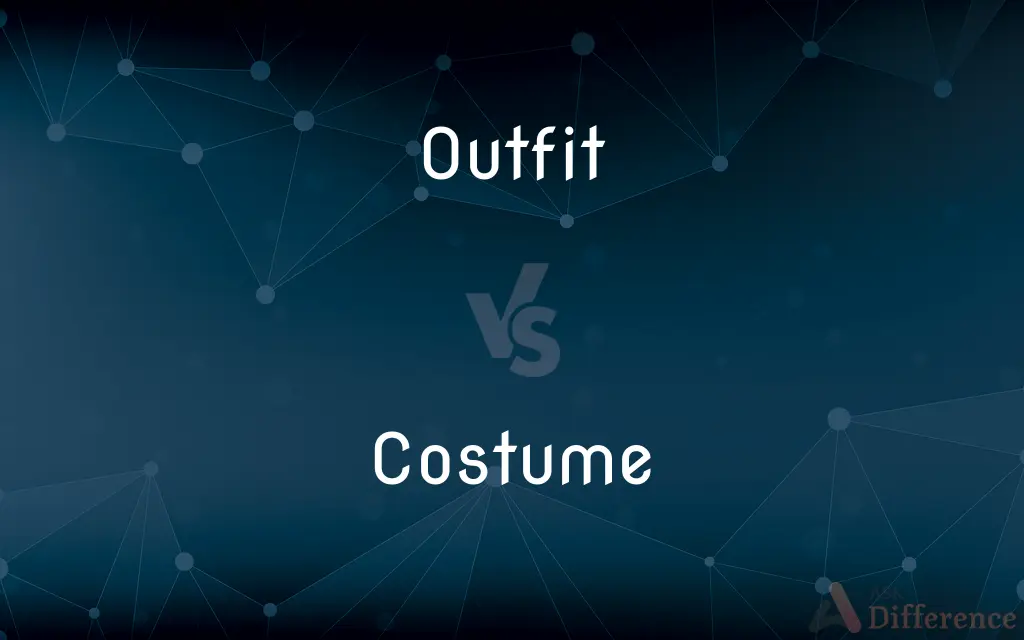Outfit vs. Costume — What's the Difference?
Edited by Tayyaba Rehman — By Urooj Arif — Updated on March 29, 2024
An outfit is everyday wear, while a costume is worn for special occasions or performances to portray a character or theme.

Difference Between Outfit and Costume
Table of Contents
ADVERTISEMENT
Key Differences
Outfits refer to the clothing one wears daily, chosen based on personal style, occasion, or functionality. In contrast, costumes are designed to transform the wearer into someone or something else, often for events like Halloween, theater performances, or themed parties.
While outfits are selected to match an individual's taste and the context of their day-to-day activities, costumes are often elaborate and aim to accurately represent a specific character, era, or concept. This distinction emphasizes the everyday utility of outfits versus the thematic, often temporary nature of costumes.
The choice of an outfit can reflect a person's mood, preferences, and social intentions, focusing on comfort, fashion, or professional standards. Costumes, however, are more about creative expression and embodying a role or idea, sometimes sacrificing comfort for authenticity or dramatic effect.
Outfits can evolve daily and are influenced by trends, weather, and personal growth. Costumes are typically created for a specific purpose and are not worn as frequently, embodying a fixed concept or character.
Despite their differences, both outfits and costumes play significant roles in self-expression and cultural practices. Outfits allow for personal expression and adaptation to various life roles, while costumes provide a temporary escape and the opportunity to explore different identities or fantasies.
ADVERTISEMENT
Comparison Chart
Purpose
Daily wear, reflecting personal style and occasion
Worn for special occasions, to portray a character or theme
Frequency of Use
Worn daily
Worn occasionally for specific events
Selection Criteria
Comfort, style, functionality
Theme, accuracy to character or era
Expression
Personal style and practicality
Creative, thematic representation
Adaptability
Changes with trends, seasons, personal preference
Specific to the character or theme it represents
Compare with Definitions
Outfit
A combination of clothes worn for everyday activities.
An outfit might include jeans, a t-shirt, and sneakers for a casual day.
Costume
A set of clothes worn to portray a character or theme.
A costume for Halloween might be a superhero outfit with all the associated accessories.
Outfit
Reflects trends and individual preferences.
An outfit can include a vintage jacket as a statement piece.
Costume
Selected for specific events like parties or performances.
A costume for a Renaissance fair may involve a detailed gown or knight’s armor.
Outfit
Can vary greatly from day to day.
Someone might choose a warm outfit with a coat and scarf for a chilly day.
Costume
Often elaborate and detailed for authenticity.
A historical drama costume might include period-accurate attire and props.
Outfit
Selected based on personal style, occasion, and comfort.
An outfit for a job interview may consist of a suit and dress shoes.
Costume
Provides a means for creative expression and role-playing.
Wearing a costume allows an individual to step into the role of their favorite fantasy character.
Outfit
Incorporates accessories for functionality and style.
An outfit may be completed with a belt, watch, or handbag.
Costume
Costume is the distinctive style of dress or cosmetic of an individual or group that reflects class, gender, profession, ethnicity, nationality, activity or epoch. In short costume is a cultural visual of the people.
Outfit
A set of tools or equipment for a specialized purpose
A welder's outfit.
Costume
A style of dress, including garments, accessories, and hairstyle, especially as characteristic of a particular country, period, or people.
Outfit
A set of clothing, often with accessories
What outfit are you wearing to the party?.
Costume
An outfit or a disguise worn on Mardi Gras, Halloween, or similar occasions.
Outfit
(Informal) An association of persons, especially a military unit or a business organization.
Costume
A set of clothes appropriate for a particular occasion or season.
Outfit
The act of equipping
The leader's outfit of the expedition.
Costume
To put a costume on; dress.
Outfit
To provide with necessary equipment
This store outfits skiers.
Costume
To design or furnish costumes for.
Outfit
A set of clothing (with accessories).
She wore a fashionable outfit with matching purse and shoes.
Costume
A style of dress, including garments, accessories and hairstyle, especially as characteristic of a particular country, period or people.
Outfit
Gear consisting of a set of articles or tools for a specified purpose.
Costume
An outfit or a disguise worn as fancy dress etc.
We wore gorilla costumes to the party.
Outfit
Any cohesive group of people; a unit; such as a military company.
Costume
A set of clothes appropriate for a particular occasion or season.
The bride wore a grey going-away costume.
Outfit
(informal) A business or firm.
Should we buy it here, or do you think the outfit across town will have a better deal?
Costume
To dress or adorn with a costume or appropriate garb.
Outfit
(sports) A sports team.
Costume
Dress in general; esp., the distinctive style of dress of a people, class, or period.
Outfit
(statistics) An outlier-sensitive fit.
Costume
Such an arrangement of accessories, as in a picture, statue, poem, or play, as is appropriate to the time, place, or other circumstances represented or described.
I began last night to read Walter Scott's Lay of the Last Minstrel . . . .I was extremely delighted with the poetical beauty of some parts . . . .The costume, too, is admirable.
Outfit
A fiscal year of the Hudson's Bay Company, or the supplies required for such a period.
Costume
A character dress, used at fancy balls or for dramatic purposes.
Outfit
(transitive) To provide with, usually for a specific purpose.
The expedition was outfitted with proper clothing, food, and other necessities.
Costume
The attire worn in a play or at a fancy dress ball;
He won the prize for best costume
Outfit
A fitting out, or equipment, as of a ship for a voyage, or of a person for an expedition in an unoccupied region or residence in a foreign land; the expense of, or allowance made for, equipment, as by the government of the United States to a diplomatic agent going abroad.
Costume
Unusual or period attire not characteristic of or appropriate to the time and place;
In spite of the heat he insisted on his woolen costume
Outfit
Any assemblage of objects required for or used in performing a task; things required as equipment for a task.
Costume
The prevalent fashion of dress (including accessories and hair style as well as garments)
Outfit
A complete ensemble of clothing, selected to form a matching set; a coordinated costume; as, a new Easter outfit.
Costume
The attire characteristic of a country or a time or a social class;
He wore his national costume
Outfit
A business enterprise; as, what outfit do you work for?.
Costume
Dress in a costume;
We dressed up for Halloween as pumpkins
Outfit
Any team or party of people.
Costume
Furnish with costumes; as for a film or play
Outfit
Any cohesive unit such as a military company
Outfit
A set of clothing (with accessories);
His getup was exceedingly elegant
Outfit
Gear consisting of a set of articles or tools for a specified purpose
Outfit
Provide with (something) usually for a specific purpose;
The expedition was equipped with proper clothing, food, and other necessities
Common Curiosities
How do outfits and costumes differ in terms of selection?
Outfits are chosen based on personal taste, comfort, and practicality, while costumes are selected to accurately represent a specific character or theme.
Why are costumes important in cultural and entertainment contexts?
Costumes are essential for storytelling, enabling performers to visually embody characters and enhancing the audience's immersion in the narrative.
What defines an outfit?
An outfit consists of clothing and accessories chosen for everyday activities, reflecting the wearer's style, needs, and the occasion.
What is the purpose of a costume?
A costume is worn to assume a different identity or represent a character/theme, often for special events or performances.
Can an outfit become a costume?
Yes, an outfit can be styled or accessorized in a way that it represents a character or theme, thus transforming it into a costume.
How do trends affect outfits and costumes?
Trends influence the styles and elements popular in daily outfits, while costume trends might relate to popular culture characters or thematic events.
What role do accessories play in outfits and costumes?
In outfits, accessories complement and complete the look, adding functionality or style. In costumes, accessories are crucial for authenticity and transforming the wearer into the character.
How do cultural differences affect outfits and costumes?
Cultural backgrounds influence the styles, significance, and types of both outfits and costumes, reflecting diverse traditions and practices.
What considerations should be made when choosing a costume for a public event?
Considerations include the event's theme, the costume's comfort and practicality, and cultural sensitivity to avoid appropriating or offending.
Are costumes always elaborate?
Not necessarily; some costumes might be simple yet effective in conveying a character or theme, depending on the creativity and intention behind them.
Can the same article of clothing be part of an outfit and a costume?
Yes, certain clothing pieces can function in both capacities, depending on how they are styled and the context in which they are worn.
How does one choose an outfit versus a costume for an event?
The choice depends on the event's nature: regular activities call for outfits, while themed parties, performances, or celebrations might require costumes.
How has social media influenced outfits and costumes?
Social media has amplified trends and provided a platform for sharing creative outfit and costume ideas, influencing choices and inspiring creativity.
What impact do costumes have on the perception of characters in films and theater?
Costumes significantly impact character portrayal and audience perception, adding depth and authenticity to the narrative.
How do environmental and ethical concerns influence outfit and costume choices?
Increasing awareness has led to more sustainable and ethical choices in both outfits and costumes, including the use of eco-friendly materials and practices.
Share Your Discovery

Previous Comparison
Jeweller vs. Jeweler
Next Comparison
Label vs. LabelingAuthor Spotlight
Written by
Urooj ArifUrooj is a skilled content writer at Ask Difference, known for her exceptional ability to simplify complex topics into engaging and informative content. With a passion for research and a flair for clear, concise writing, she consistently delivers articles that resonate with our diverse audience.
Edited by
Tayyaba RehmanTayyaba Rehman is a distinguished writer, currently serving as a primary contributor to askdifference.com. As a researcher in semantics and etymology, Tayyaba's passion for the complexity of languages and their distinctions has found a perfect home on the platform. Tayyaba delves into the intricacies of language, distinguishing between commonly confused words and phrases, thereby providing clarity for readers worldwide.
















































